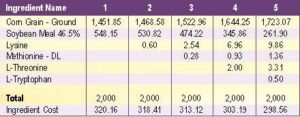Whether you grow your soybeans or buy and bank them from a local co-op, they are likely your main source of protein if you raise swine or poultry. Depending on the previous year’s crop, you could find yourself looking for ways to extend your supply. High corn prices have many people talking about planting more corn this spring to create a surplus and hopefully bring down prices—more acres with corn results in fewer acres with soybeans. Soybean inventory could become the next issue.
Amino acids are the most efficient way to reduce soybean meal usage in the feed. Before synthetic amino acids were readily available, we would formulate diets to satisfy crude protein requirements rather than for specific amino acids. Using synthetic amino acids isn’t new. Modern nutrition recognizes protein quality is typically more important than quantity with respect to performance. We have been doing this for decades and understand the advantages, but it’s worth taking a closer look to understand and get a refresher on how it can be beneficial.
Below is a chart demonstrating the value of adding amino acids to feed. Five examples of the same diet are shown, each with an additional amino acid added to meet the dietary needs. This example is based on swine amino acid ratios. However, the same principle applies to poultry as well. As the number of amino acids used increases, the total amount of soybean meal decreases. Reducing pounds can help plan your protein needs for the year.

In addition to reducing protein-providing ingredient needs, diet cost is reduced. In this example what is important is the relative cost difference, not the absolute value. Changing from a straight corn-soy diet to a diet using four amino acids can save twenty dollars per ton. Use this information to help make decisions for your operation and plan for the year ahead.
